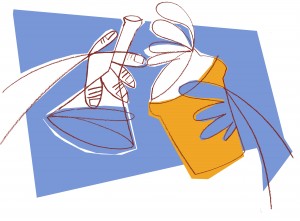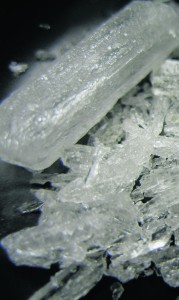MONDAY, 3 OCTOBER 2011
Aristotle once said “there was never a genius without a tincture of madness”. Indeed, some of the most brilliant chemical reactions are so hazardous that their discovery surely involved a mad burst of Aristotelian inspiration. The Birch Reduction is one such reaction.Discovered over 60 years ago, the reaction was first performed by the Australian chemist Arthur Birch. Birch, whose auspicious career led him to be honoured as a Fellow of the Royal Society in the United Kingdom and a Companion of the Order of Australia at home, devised the reaction at the University of Oxford during the Second World War. At that time, the RAF had become suspicious that Nazi fighter pilots were taking hormones in order to improve their performance in the air. Arthur Birch was instructed to generate some suitable hormonal analogues in order to level the playing field. The compounds he generated were modified steroids, the best known of which was nandroline (19-nortestostorone).
Nandroline is only prescribed rarely nowadays, but in the past has been used to treat both osteoporosis and anaemia. It also has a notorious history in athletics as a performance-enhancing drug; it was the compound that Linford Christie, the UK 100 metre Olympic gold medallist, tested positive for in August 1999, effectively ending his athletic career. Birch’s pioneering work also paved the way for the synthesis of other compounds in the same steroid family: progestins. This included one of the two active ingredients in the first oral contraceptive pill, norethynodrel, which was approved under the name Enovid in 1960.
In order to synthesise his steroids, Birch needed to remove a double bond from certain six-membered, carbon-based rings. These so-called ‘aromatic’ rings, owing to their often odoriferous nature, then form their corresponding 1,4-cyclohexadienes. This is no mean feat because, as Birch noted himself, “[it is] not possible by the standard methods of catalytic reduction, since the desired compounds are more readily reducible than the starting materials.” Essentially, Birch was making the observation that aromatic rings prefer to lose all their double bonds or none at all.
Unperturbed, Birch built upon the accidental discovery of Charles Wooster and Ken Godfrey: that an ammoniacal solution of sodium metal could be employed to do just the job. It isn’t clear how they happened upon this discovery, not least because the original report is a classic case of understated scientific prose. Nonetheless, it is appealing to imagine Wooster and Godfrey dreaming up the experiment in an idle moment, and deciding to carry it out in those last (otherwise unproductive) hours of the working week. Or perhaps, they had an inkling of how the chemistry might work out: a genuine spark of scientific inspiration that they were convinced would generate their desired outcome. Either way, their foray into the alkali metals inspired Birch to reach for his lecture bottle of ammonia and start investigating.
Birch’s reaction involves the combination of an alkali metal (lithium, sodium or potassium) with an alcoholic solution of the target aromatic compound in liquid ammonia. The sodium, keen to lose an electron, becomes ionised to Na+, resulting in an intensely blue solution. The colour is attributed to the so-called ‘solvated electron’, which is stabilised by a cage of ammonia molecules. This electron is then donated to the aromatic ring, which gains a negative charge and consequently nips a proton off the alcohol.
The immediate dark blue resulting from the addition of the sodium metal is a satisfying change from the mundane, yellow or colourless solutions in which chemists deal routinely. But it also delivers a profound statement about the underlying mechanics of chemical reactions: the blue shade is electrons. The colour is derived directly from the size of the ‘ammonia cage’ within which the electron is forced to rattle, prior to its attack of the aromatic ring.
With great reactions, however, come great responsibilities, and the Birch Reduction is not without its hazards. It is necessary to condense hundreds of millilitres of ammonia, usually a gas, at a temperature of less than 40˚C. Following this, solid sodium must be cut up and weighed out, all the while being kept under oil since it will spontaneously burst into flames if it comes into contact with moisture. The subsequent change in colour is also a distraction from a more subtle change in the reaction: the volume of the solution increases. This change stems from the extra organisation required to arrange ammonia molecules around the free electrons in their ‘ammonia cage’ geometry. The final challenge comes in quenching the reaction. A large excess of ammonium chloride—a relatively harmless white solid similar to table salt—is added to the solution. This has roughly the same effect as adding a large excess of sugar to a rapidly stirred bottle of Coca-Cola. The difference is that instead of producing a sweet foamy mess of carbonated drink, the reaction flask has a tendency to erupt with a fountain of liquid and gaseous ammonia.
Although the reaction is still widely used to this day in research laboratories, it is hardly seen in industry, where the combination of very large volumes of liquid ammonia and sodium would raise a few too many Health and Safety eyebrows. Perhaps the most infamous industrial application of the Birch Reduction is in the synthesis of methamphetamine, better known on the streets as the drug Crystal Meth. In this case, the intention is not to remove double bonds from aromatic rings, but to chemically modify pseudoephedrine, which is the active ingredient in decongestants like Sudafed. Criminal drug labs have to be inventive in order to gather the ingredients for a large scale Birch Reduction. Usually, the ammonia is obtained from fertiliser and lithium (from non-rechargeable batteries) is used in place of sodium. It is hazardous work—indeed, an estimated 15 percent of drug busts on illicit meth labs involve police being tipped off by an explosion or a fire.
On the other hand, the Birch reduction is routinely undertaken in the research laboratory without such drama. It is not only a classic reaction, but also a genuinely useful one—it does unusual chemistry, it scales up well and, frankly, it is quite pleasing to look at too. Certainly, chemistry would be the poorer without that flash of imagination that inspired Arthur Birch to throw caution to the wind and drop sodium in his test tube.
Simon Page is a PhD student in the Department of Chemistry



